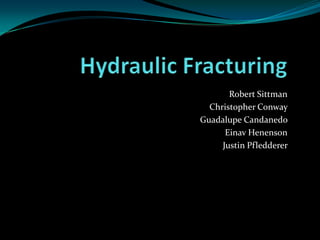Hydraulic fracturing presentation
- 1. Robert Sittman Christopher Conway Guadalupe Candanedo Einav Henenson Justin Pfledderer
- 3. 2005 Energy Act Advances in the HF process Chemicals
- 4. Enormous potential for both the economy and the environment Jobs!!! Greenhouse gas advantages National security benefits Lower costs to consumers A safe process
- 7. Intragenerational inequality- certain people suffer while others benefit Intergenerational inequality- contaminated water resources for the future Interspecies inequalityŌĆō animals are harmed
- 8. Social Marginal Cost $ Private Marginal Cost $* Marginal Damage Marginal Benefit Q* Q
- 9. Environmental damage Technical advances Policy design and evaluation Cost of policies
- 10. Pass the 2012 Frac Act Technological based performance standard Performance bond Quasi option value
- 12. References ’éŚ Adams, G., Hayes, S., Wejerter, S. and Boyd, J. (2007, October 24). Regulatory Capture: Managing the Risk. ICE Australia, International Conferences and Events. Retrieved April 14, 2011 ’éŚ ’éŚ Arthur, J.D. (2008, September 21). Hydraulic Fracturing Considerations for Natural Gas Wells in Marcellus Shale. Presented to The Ground Water Protection Council September 21-24, 2008. Retrieved from Google Scholar ’éŚ ’éŚ Cavner, R. (2011, February 8). Responding to the Hydraulic Fracturing Issue. Daily Hurricane. ’éŚ Retrieved from http://www.huffingtonpost.com/robert-l-cavnar/responding-to-the-hydraul_b_820215.html ’éŚ ’éŚ Chesapeake Energy (2010). Natural gas Water Usage Facts. Retrieved from: http://www.hydraulicfracturing.com/Pages/information.aspx ’éŚ ’éŚ Environmental Protection Agency. (2004). EPA Study on Hydraulic Fracturing. Retrieved from http://www.epa.gov/ogwdw/uic/pdfs/cbmstudy_attach_uic_ch07_conclusions.pdf ’éŚ ’éŚ Energy in Depth. (2010, June 9). Debunking Gasland. Retrieved from http://www.energyindepth.org/2010/06/debunking-gasland/ ’éŚ ’éŚ Fox, J. (Director). (2009). Gasland [Motion Picture]. United States: Docuramafilms. ’éŚ ’éŚ Fox, J. (2010, July 12) Affirming Gasland: A De-debunking Document in Response to Specious and Misleading Gas Industry Claims against the Film. Retrieved from ’éŚ http://1trickpony.cachefly.net/gas/pdf/Affirming_Gasland_Sept_2010.pdf ’éŚ Keohane, N. & Olmstead, S. (2007). Markets and the Environment. Washington: Island Press ’éŚ ’éŚ Kerr, R. (2011, August 11). Federal Committee: Shale Gas Needs Openness, Better Data. Science Insider http://news.sciencemag.org/scienceinsider/2011/08/federal-committee-shale-gas-need.html?ref=hp ’éŚ ’éŚ Lustgarden, A. (2011, January 25). Buried Secrets: Gas DrillingŌĆÖs Climate Benefits May Overstated and Possible Environmental Threat. Pro Publica: Journalism in the Public Interest. Retrieved from ’éŚ http://www.propublica.org/article/natural-gas-and-coal-pollution-gap-in-doubt ’éŚ
- 13. References ’éŚ Montgomery, C. & Smith, M. (2010, December). Hydraulic Fracturing: History of an Enduring ’éŚ Technology. Journal of Petroleum Technology (Society of Petroleum Engineers) 62 (12): 26-32 ’éŚ ’éŚ Nadar, L. (2010). The Energy Reader. Malden, MA: Willey-Blackwell Publishing ’éŚ ’éŚ Nelson, P. (2011, July 18) Resources for the future. RFF Launches New Initiative on Risks and Regulations of Shale Gas. Retrieved from: http://www.rff.org/News/Press_Releases/Pages/RFF-Launches-New-Initiative-on-Risks-and-Regulation-of-Shale-Gas.aspx ’éŚ ’éŚ Rubinkan, M. & Caruso, D. (2011, April 12). Fracking Shale for Gas brings Wealth, Concerns. The Huffington Post.http://www.huffingtonpost.com/huff-wires/20110412/us-gas-drilling-impact/ ’éŚ ’éŚ Urbana, I. (2011, February 26). Regulation Lax as Gas WellsŌĆÖ tainted water Hits River. The New York Times. http://www.nytimes.com/2011/02/27/us/27gas.html?_r=1&hp ’éŚ Walsh, B. (2011, March 31). Could Shale Gas Power the World. Time Magazine. Retrieved from:http://www.time.com/time/health/article/0,8599,2062331-4,00.html ’éŚ ’éŚ Wilson, W. (2007, October 4). Letters from EPA Fracking Study Whistleblower. Earthworks: Protecting Communities and the Environment. Retrieved from: http://www.earthworksaction.org/publications.cfm?pubID=372 ’éŚ ’éŚ Wiseman, H. J. (2008, September 23) Untested Waters: The Rise of Hydraulic Fracturing in Oil and Gas Production and the Need to Revisit Regulation. Fordham Environmental Law Review. Vol 20. P. 115, 2009. SSRN: http://ssrn.com/adstract=1595092
Editor's Notes
- #3: http://youtu.be/X8du6pQbvyo
- #4: Explain the changes that took place the past 10 years in regards to HF┬Ā┬Ā┬Ā┬Ā┬Ā ┬Ā- Horizontal Drilling┬Ā┬Ā┬Ā┬Ā┬Ā┬Ā - Right to patent chemicals that are added to HF water (preventing from society to investigate the damage associated with them)┬Ā┬Ā┬Ā┬Ā┬Ā ┬Ā- 2005 signing of the Energy Act to exempt Gas and oil companies for compiling with Clean Water Act.
- #7: Degraded landscapes/ecosystems1 to 7 million gallons of water used per well (each well is fracked an average of 18 times)Emissions released to air and waterPolluted ground waterSurface spillsProduction water? What to do with it. Methane released into the air.
- #8: Intragenerational inequality (most damage is absorbed by┬Āpeople who live next to the wells,┬Āhowever all the country use the gas and oil, as well as people who lives┬Ā next┬Āto other people who leased their property for wells also suffer from the pollution but receive no money or compensation for it)┬Ā┬Ā┬Ā┬Ā┬Ā┬Ā - Intergenerational inequality (Contaminated resources will┬Ā live no resources for new generation)┬Ā┬Ā┬Ā┬Ā┬Ā┬Ā - Interspecies inequality (Animals suffer- lose hair, health issues..)











![References
’éŚ Adams, G., Hayes, S., Wejerter, S. and Boyd, J. (2007, October 24). Regulatory Capture: Managing the Risk. ICE Australia, International
Conferences and Events. Retrieved April 14, 2011
’éŚ
’éŚ Arthur, J.D. (2008, September 21). Hydraulic Fracturing Considerations for Natural Gas Wells in Marcellus Shale. Presented to The Ground
Water Protection Council September 21-24, 2008. Retrieved from Google Scholar
’éŚ
’éŚ Cavner, R. (2011, February 8). Responding to the Hydraulic Fracturing Issue. Daily Hurricane.
’éŚ Retrieved from http://www.huffingtonpost.com/robert-l-cavnar/responding-to-the-hydraul_b_820215.html
’éŚ
’éŚ Chesapeake Energy (2010). Natural gas Water Usage Facts. Retrieved from: http://www.hydraulicfracturing.com/Pages/information.aspx
’éŚ
’éŚ Environmental Protection Agency. (2004). EPA Study on Hydraulic Fracturing. Retrieved from
http://www.epa.gov/ogwdw/uic/pdfs/cbmstudy_attach_uic_ch07_conclusions.pdf
’éŚ
’éŚ Energy in Depth. (2010, June 9). Debunking Gasland. Retrieved from http://www.energyindepth.org/2010/06/debunking-gasland/
’éŚ
’éŚ Fox, J. (Director). (2009). Gasland [Motion Picture]. United States: Docuramafilms.
’éŚ
’éŚ Fox, J. (2010, July 12) Affirming Gasland: A De-debunking Document in Response to Specious and Misleading Gas Industry Claims against the
Film. Retrieved from
’éŚ http://1trickpony.cachefly.net/gas/pdf/Affirming_Gasland_Sept_2010.pdf
’éŚ Keohane, N. & Olmstead, S. (2007). Markets and the Environment. Washington: Island Press
’éŚ
’éŚ Kerr, R. (2011, August 11). Federal Committee: Shale Gas Needs Openness, Better Data. Science Insider
http://news.sciencemag.org/scienceinsider/2011/08/federal-committee-shale-gas-need.html?ref=hp
’éŚ
’éŚ Lustgarden, A. (2011, January 25). Buried Secrets: Gas DrillingŌĆÖs Climate Benefits May Overstated and Possible Environmental Threat. Pro
Publica: Journalism in the Public Interest. Retrieved from
’éŚ http://www.propublica.org/article/natural-gas-and-coal-pollution-gap-in-doubt
’éŚ](https://image.slidesharecdn.com/sos325hydraulicfracturingpresentation-130204173637-phpapp02/85/Hydraulic-fracturing-presentation-12-320.jpg)
